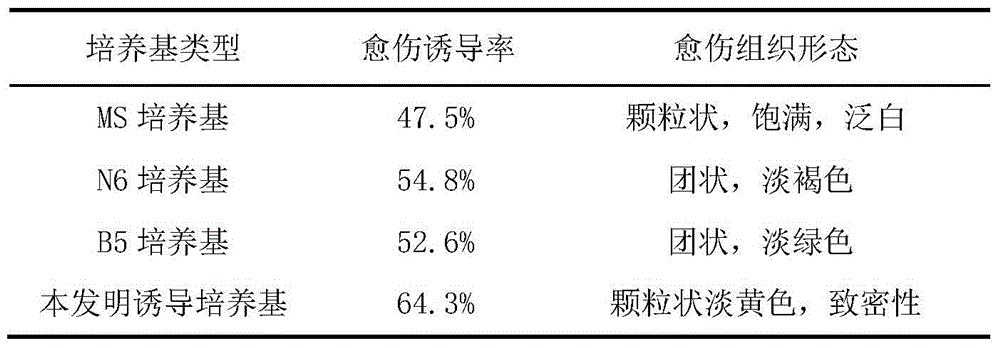Method for Inducing Callus Formation from Phyllostachys pubescens Seed Embryo
A technology of callus and moso bamboo, which is applied in the field of forestry biotechnology and tissue culture, can solve the problems of difficult material collection, high pollution rate, browning, etc., and achieve the effect of ensuring disinfection effect, reducing pollution rate and good growth state
- Summary
- Abstract
- Description
- Claims
- Application Information
AI Technical Summary
Problems solved by technology
Method used
Image
Examples
Embodiment 1
[0023] The method for moso bamboo seed embryo induction callus formation comprises the following steps:
[0024] (1) Screening of seeds
[0025] Get the bamboo seeds, peel off the lemma, use the TTC staining method to measure the vitality of the bamboo seeds, and screen the bamboo seeds with 80% vigor;
[0026] (2) Disinfection of seed embryos
[0027] Take out the seed embryo of the Phyllostachys pubescens seed that screens out, excise 70% endosperm, wash 2 hours with running water, then place 75% (v / v) ethanol and soak 2 minutes, rinse with sterile water again until the surface is smooth, the back groove There is no obvious foreign matter in the tank, then under aseptic conditions, soak and shake in 2% (v / v) sodium hypochlorite solution for 15 minutes, then rinse with sterile water until the surface is smooth and there is no obvious foreign matter in the groove on the back, and finally in the Under aseptic conditions, place in 0.1% (w / v) mercuric chloride with 4 drops of T...
Embodiment 2
[0033] The method for moso bamboo seed embryo induction callus formation comprises the following steps:
[0034] (1) Screening of seeds
[0035] Get the moso bamboo seeds, peel off the lemma, adopt the TTC staining method to carry out the viability measurement to the moso bamboo seeds, and screen the moso bamboo seeds whose birth vigor is 85%;
[0036] (2) Disinfection of seed embryos
[0037] Take out the seed embryo of the Phyllostachys pubescens seed that screens out, excise 50% endosperm, wash 3 hours with running water, then place 70% (v / v) ethanol and soak for 4 minutes, rinse with sterile water again until the surface is smooth, the back groove There is no obvious foreign matter in the tank, then under aseptic conditions, soak and shake in 1.5% (v / v) sodium hypochlorite solution for 18 minutes, then rinse with sterile water until the surface is smooth and there is no obvious foreign matter in the groove on the back, and finally in the Under aseptic conditions, soak an...
Embodiment 3
[0043] The method for moso bamboo seed embryo induction callus formation comprises the following steps:
[0044] (1) Screening of seeds
[0045] Get the moso bamboo seeds, peel off the lemma, and adopt the TTC staining method to measure the viability of the moso bamboo seeds, and screen the moso bamboo seeds whose vigor is 90%;
[0046] (2) Disinfection of seed embryos
[0047]Take out the germ embryo of the Phyllostachys pubescens seed that screens out, excise 60% endosperm, wash 4 hours with running water, place 72% (v / v) ethanol then to soak 3 minutes, rinse with sterile water again until the surface is smooth, the back groove There is no obvious foreign matter in the tank, then under aseptic conditions, soak and shake in 1% (v / v) sodium hypochlorite solution for 20 minutes, then rinse with sterile water until the surface is smooth and there is no obvious foreign matter in the groove on the back, and finally in the Under aseptic conditions, place in 0.08% (w / v) mercuric c...
PUM
 Login to View More
Login to View More Abstract
Description
Claims
Application Information
 Login to View More
Login to View More - R&D
- Intellectual Property
- Life Sciences
- Materials
- Tech Scout
- Unparalleled Data Quality
- Higher Quality Content
- 60% Fewer Hallucinations
Browse by: Latest US Patents, China's latest patents, Technical Efficacy Thesaurus, Application Domain, Technology Topic, Popular Technical Reports.
© 2025 PatSnap. All rights reserved.Legal|Privacy policy|Modern Slavery Act Transparency Statement|Sitemap|About US| Contact US: help@patsnap.com



